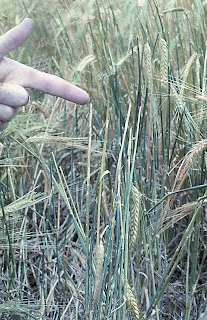WATCH FOR ARMYWORMS IN BARLEY AND OATS
Description and Life History

Damage
During the vegetative growth phase, plants can tolerate considerable leaf feeding. Leaves may look tattered from the eaten-out leaf margins. Faecal pellets around the base of plants are another indication of armyworm infestation. Armyworm generally do not require control during the vegetative stage.

The most serious armyworm damage in cereal crops occurs when larvae feed on the upper flag leaf and stem node as the crop matures. Larvae target the stem node as the leaves become dry and unpalatable, and the stem is often the last part of the plant to dry. Head cutting begins at this time. One large larva can sever up to seven heads of barley a day. One larva a square metre can cause a loss of 70 kg/ha grain per day. A larva takes around 8-10 days to develop through the final, most damaging instars, so the crop is susceptible to maximum damage for this period. The current high value of barley (over $400/tonne) would suggest keeping a close watch on armyworm infestations in maturing crops.
Armyworm populations in ripening crops in excess of 1 large larva per square metre will usually warrant spraying. For insecticide application to be economic, check or scout the crop and assess the problem before head cutting starts. Check for larvae on the plant and in the soil litter under the plant. Late in the day, when the larvae are becoming active, use a sweep net (or swing a bucket through the crop) to make a quick assessment of whether armyworm larvae are present in the crop. Infestations are often patchy, so check a number of sites across the field.
Early recognition
It is essential to recognise the problem early and be prepared to spray when economic damage is imminent. A barley crop can be almost destroyed by armyworm in just a few days. Whilst large larvae do the head lopping, controlling smaller larvae that are still leaf feeding may be more achievable.
Control
Many chemicals will control armyworms. However their effectiveness is often dependent on good penetration into the crop to get contact with the caterpillars. Control may be more difficult in high-yielding thick canopy crops, particularly when larvae are resting under leaf litter at the base of plants. As larvae are most active at night, spraying in the afternoon or evening may produce the best results. If applying sprays close to harvest, be aware of relevant Withholding Periods. Always read the label.
Biological control agents may be important in some years. These include parasitic flies and wasps, predatory beetles and diseases.
Further information:
Common, northern and sugar-cane armyworms in pasture, and winter cereals, maize and sorghum. http://www2.dpi.qld.gov.au/beef/3250.html
Labels: Winter cereals



